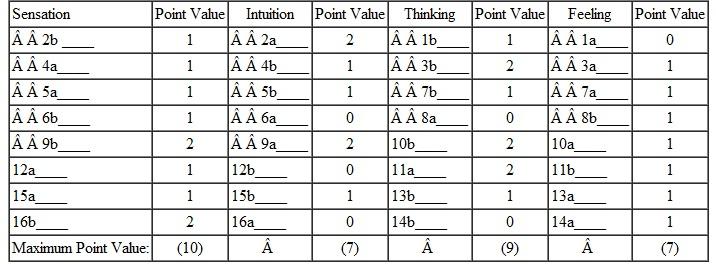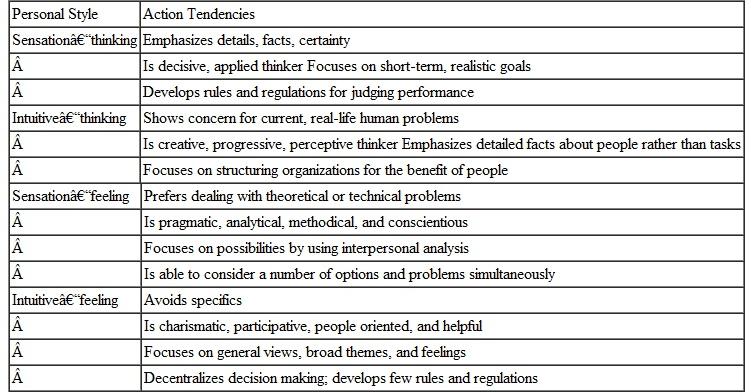
Fundamentals of Selling 13th Edition by Charles Futrell
Edition 13ISBN: 978-0077861018
Fundamentals of Selling 13th Edition by Charles Futrell
Edition 13ISBN: 978-0077861018 Exercise 12
Individuals differ in the way they interact with others and the way they gather and evaluate information for problem solving and decision making. Four psychological functions identified by Carl Jung are related to this process: sensation, intuition, thinking, and feeling. 2
Before you read further, complete the problem-solving diagnostic questionnaire (Part A) and then check the scoring key that appears in Part B. 3 It has no right or wrong answers; just read each item carefully and then give your answer.
Part A: Questionnaire to Determine Your Style
Indicate your responses to the following questionnaire on a separate sheet of paper. None of these items has right or wrong responses.
I. Write down the number and letter of the response that comes closest to how you usually feel or act.
1. I am more careful about
a. People's feelings.
b. Their rights.
2. I usually get along better with
a. Imaginative people.
b. Realistic people.
3. It is a higher compliment to be called
a. A person of real feeling.
b. A consistently reasonable person.
4. In doing something with many people, it appeals more to me
a. To do it in the accepted way.
b. To invent a way of my own.
5. I get more annoyed at
a. Fancy theories.
b. People who do not like theories.
6. It is higher praise to call someone
a. A person of vision.
b. A person of common sense.
7. I more often let
a. My heart rule my head.
b. My head rule my heart.
8. I think it is a worse fault
a. To show too much warmth.
b. To be unsympathetic.
9. If I were a teacher, I would rather teach
a. Courses involving theory.
b. Fact courses.
II. Write down the letters of the words in the following pairs that appeal to you more.
10.a. compassion
b. foresight
11.a. justice
b. mercy
12.a. production
b. design
13.a. gentle
b. firm
14.a. uncritical
b. critical
15.a. literal
b. figurative
16.a. imaginative
b. matter of fact
According to Jung, only one of the four functions-sensation, intuition, thinking, or feeling-is dominant in an individual. However, the dominant function is usually backed up by one of the functions from the other set of paired opposites. Part C shows the four problem-solving styles that result from these matchups.
Part B: Scoring Key to Determine Your Style
The following scales indicate the psychological functions related to each item. Use the point-value columns to arrive at your score for each function. For example, if you answered a to the first question, your Ia response in the feeling column is worth 0 points when you add up the point-value column. Instructions for classifying your scores follow the scales.
Classifying Total Scores
• Write intuition if your intuition score is equal to or greater than your sensation score.
• Write sensation if your sensation score is greater than your intuition score.
• Write feeling if your feeling score is greater than your thinking score.
• Write thinking if your thinking score is greater than your feeling score.
Part C: The Four Problem-Solving Styles and Their Tendencies
According to Jung, gathering information and evaluating information are separate activities. People gather information by either sensation or intuition but not by both simultaneously. People using sensation would rather work with known facts and hard data and prefer routine and order while gathering information. People using intuition would rather look for possibilities than work with facts and prefer solving new problems and using abstract concepts.
Information evaluation involves making judgments about the information a person has gathered. People evaluate information by thinking or feeling. These represent the extremes in orientation. Thinking individuals base their judgments on impersonal analysis, using reason and logic rather than personal values or emotional aspects of the situation. Feeling individuals base their judgments more on personal feelings, such as harmony, and tend to make decisions that result in approval from others.
Also see Exhibit: Guidelines to Identifying Personality Style. Compare yourself and others you know to the guidelines. Do you find a match between you and the individual style What about your roommate, spouse, parents, or siblings
EXHIBIT
Which of the five communication modes can a salesperson look for with these customers
Before you read further, complete the problem-solving diagnostic questionnaire (Part A) and then check the scoring key that appears in Part B. 3 It has no right or wrong answers; just read each item carefully and then give your answer.
Part A: Questionnaire to Determine Your Style
Indicate your responses to the following questionnaire on a separate sheet of paper. None of these items has right or wrong responses.
I. Write down the number and letter of the response that comes closest to how you usually feel or act.
1. I am more careful about
a. People's feelings.
b. Their rights.
2. I usually get along better with
a. Imaginative people.
b. Realistic people.
3. It is a higher compliment to be called
a. A person of real feeling.
b. A consistently reasonable person.
4. In doing something with many people, it appeals more to me
a. To do it in the accepted way.
b. To invent a way of my own.
5. I get more annoyed at
a. Fancy theories.
b. People who do not like theories.
6. It is higher praise to call someone
a. A person of vision.
b. A person of common sense.
7. I more often let
a. My heart rule my head.
b. My head rule my heart.
8. I think it is a worse fault
a. To show too much warmth.
b. To be unsympathetic.
9. If I were a teacher, I would rather teach
a. Courses involving theory.
b. Fact courses.
II. Write down the letters of the words in the following pairs that appeal to you more.
10.a. compassion
b. foresight
11.a. justice
b. mercy
12.a. production
b. design
13.a. gentle
b. firm
14.a. uncritical
b. critical
15.a. literal
b. figurative
16.a. imaginative
b. matter of fact
According to Jung, only one of the four functions-sensation, intuition, thinking, or feeling-is dominant in an individual. However, the dominant function is usually backed up by one of the functions from the other set of paired opposites. Part C shows the four problem-solving styles that result from these matchups.
Part B: Scoring Key to Determine Your Style
The following scales indicate the psychological functions related to each item. Use the point-value columns to arrive at your score for each function. For example, if you answered a to the first question, your Ia response in the feeling column is worth 0 points when you add up the point-value column. Instructions for classifying your scores follow the scales.
Classifying Total Scores
• Write intuition if your intuition score is equal to or greater than your sensation score.
• Write sensation if your sensation score is greater than your intuition score.
• Write feeling if your feeling score is greater than your thinking score.
• Write thinking if your thinking score is greater than your feeling score.

Part C: The Four Problem-Solving Styles and Their Tendencies

According to Jung, gathering information and evaluating information are separate activities. People gather information by either sensation or intuition but not by both simultaneously. People using sensation would rather work with known facts and hard data and prefer routine and order while gathering information. People using intuition would rather look for possibilities than work with facts and prefer solving new problems and using abstract concepts.
Information evaluation involves making judgments about the information a person has gathered. People evaluate information by thinking or feeling. These represent the extremes in orientation. Thinking individuals base their judgments on impersonal analysis, using reason and logic rather than personal values or emotional aspects of the situation. Feeling individuals base their judgments more on personal feelings, such as harmony, and tend to make decisions that result in approval from others.
Also see Exhibit: Guidelines to Identifying Personality Style. Compare yourself and others you know to the guidelines. Do you find a match between you and the individual style What about your roommate, spouse, parents, or siblings
EXHIBIT
Which of the five communication modes can a salesperson look for with these customers

Explanation

This question doesn’t have an expert verified answer yet, let Quizplus AI Copilot help.
Fundamentals of Selling 13th Edition by Charles Futrell
Why don’t you like this exercise?
Other Minimum 8 character and maximum 255 character
Character 255



